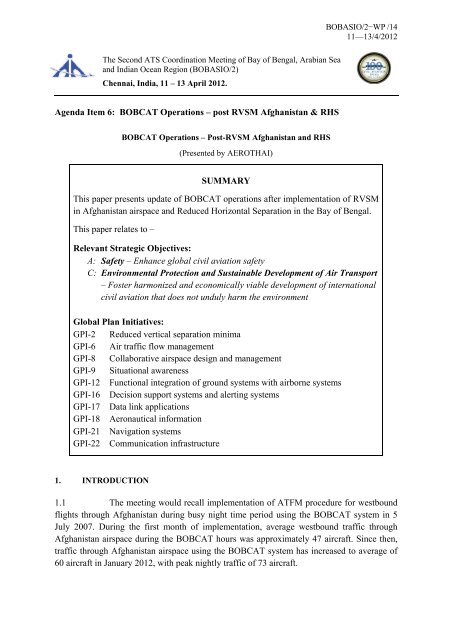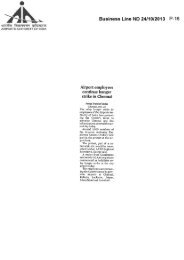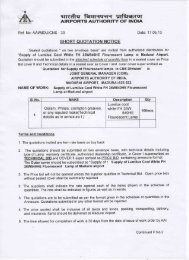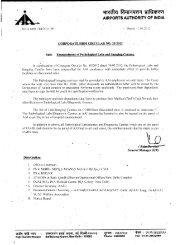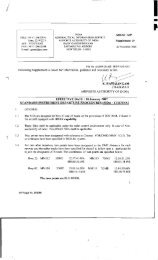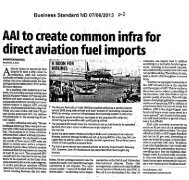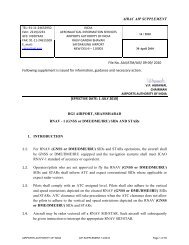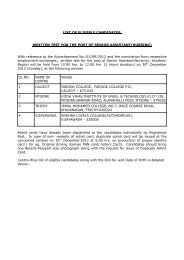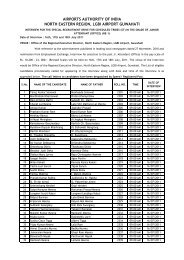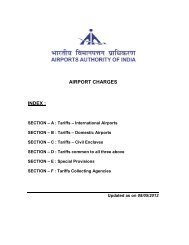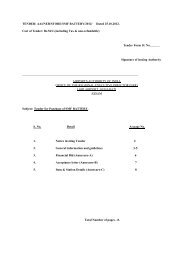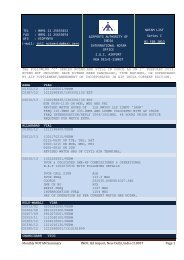BOBCAT Operations – post RVSM Afghanistan & RHS
BOBCAT Operations – post RVSM Afghanistan & RHS
BOBCAT Operations – post RVSM Afghanistan & RHS
You also want an ePaper? Increase the reach of your titles
YUMPU automatically turns print PDFs into web optimized ePapers that Google loves.
The Second ATS Coordination Meeting of Bay of Bengal, Arabian Sea<br />
and Indian Ocean Region (BOBASIO/2)<br />
Chennai, India, 11 <strong>–</strong> 13 April 2012.<br />
Agenda Item 6: <strong>BOBCAT</strong> <strong>Operations</strong> <strong>–</strong> <strong>post</strong> <strong>RVSM</strong> <strong>Afghanistan</strong> & <strong>RHS</strong><br />
<strong>BOBCAT</strong> <strong>Operations</strong> <strong>–</strong> Post-<strong>RVSM</strong> <strong>Afghanistan</strong> and <strong>RHS</strong><br />
(Presented by AEROTHAI)<br />
SUMMARY<br />
BOBASIO/2−WP /14<br />
11—13/4/2012<br />
This paper presents update of <strong>BOBCAT</strong> operations after implementation of <strong>RVSM</strong><br />
in <strong>Afghanistan</strong> airspace and Reduced Horizontal Separation in the Bay of Bengal.<br />
This paper relates to <strong>–</strong><br />
Relevant Strategic Objectives:<br />
A: Safety <strong>–</strong> Enhance global civil aviation safety<br />
C: Environmental Protection and Sustainable Development of Air Transport<br />
<strong>–</strong> Foster harmonized and economically viable development of international<br />
civil aviation that does not unduly harm the environment<br />
Global Plan Initiatives:<br />
GPI-2 Reduced vertical separation minima<br />
GPI-6 Air traffic flow management<br />
GPI-8 Collaborative airspace design and management<br />
GPI-9 Situational awareness<br />
GPI-12 Functional integration of ground systems with airborne systems<br />
GPI-16 Decision support systems and alerting systems<br />
GPI-17 Data link applications<br />
GPI-18 Aeronautical information<br />
GPI-21 Navigation systems<br />
GPI-22 Communication infrastructure<br />
1. INTRODUCTION<br />
1.1 The meeting would recall implementation of ATFM procedure for westbound<br />
flights through <strong>Afghanistan</strong> during busy night time period using the <strong>BOBCAT</strong> system in 5<br />
July 2007. During the first month of implementation, average westbound traffic through<br />
<strong>Afghanistan</strong> airspace during the <strong>BOBCAT</strong> hours was approximately 47 aircraft. Since then,<br />
traffic through <strong>Afghanistan</strong> airspace using the <strong>BOBCAT</strong> system has increased to average of<br />
60 aircraft in January 2012, with peak nightly traffic of 73 aircraft.
BOBASIO/2<strong>–</strong>WP /14 -2-<br />
1.2 The meeting is advised of <strong>RVSM</strong> implementation in <strong>Afghanistan</strong>, Russian<br />
Federation and other Central Asian States on AIRAC 17 November 2011.<br />
1.3 The meeting would also recall implementation of Reduced Horizontal<br />
Separation across the Bay of Bengal airspace taking advantage of airborne RNP10 equipage<br />
and appropriate Direct Controller-Pilot Communications (DCPC) in various stages from<br />
AIRAC 30 June 2011 to AIRAC 12 January 2012.<br />
2. DISCUSSION<br />
Airspace Configuration<br />
2.1 The meeting is reminded of current <strong>Afghanistan</strong> upper airspace structure in Figure 1.<br />
Figure 1: Current <strong>Afghanistan</strong> Upper Airspace<br />
2.2 The meeting is advised of <strong>BOBCAT</strong> airspace configuration prior to<br />
<strong>Afghanistan</strong> <strong>RVSM</strong> implementation in 17 November 2011 in Figure 2.<br />
Entry<br />
Waypoint<br />
Route Spacing Parameter Flight Level<br />
LAJAK L509 MURAD M875 10 minutes + 5 minutes F310 | F350 | F390<br />
PAVLO N644 10 minutes + 5 minutes F280 | F310 | F350 | F390<br />
ROSIE L750 10 minutes + 5 minutes F280 | F310 | F350 | F390<br />
ASLUM P628 10 minutes + 5 minutes F310 | F350 | F390<br />
SERKA N636 PAROD P628 10 minutes + 5 minutes F310 | F350 | F390<br />
SERKA UL333 No slot required F310 | F350 | F390<br />
Figure 2: <strong>BOBCAT</strong> Airspace Configuration before <strong>Afghanistan</strong> <strong>RVSM</strong>
-3- BOBASIO/2<strong>–</strong>WP/14<br />
2.3 The meeting is advised of <strong>BOBCAT</strong> airspace configuration after <strong>Afghanistan</strong><br />
<strong>RVSM</strong> implementation on 17 November 2011 in Figure 3.<br />
Entry<br />
Waypoint<br />
Route Spacing Parameter Flight Level<br />
LAJAK L509 MURAD M875 10 minutes + 5 minutes F320 | F340 | F360 | F380 | F400<br />
PAVLO N644 10 minutes + 5 minutes F280 | F320 | F340 | F360 | F380 | F400<br />
ROSIE L750 10 minutes + 5 minutes F280 | F320 | F340 | F360 | F380 | F400<br />
ASLUM P628 10 minutes + 5 minutes F320 | F340 | F360 | F380 | F400<br />
SERKA N636 PAROD P628 10 minutes + 5 minutes F320 | F340 | F360 | F380 | F400<br />
SERKA UL333 No slot required F320 | F340 | F360 | F380 | F400<br />
Figure 3: <strong>BOBCAT</strong> Airspace Configuration after <strong>Afghanistan</strong> <strong>RVSM</strong><br />
2.4 The meeting should note that implementation of <strong>RVSM</strong> in <strong>Afghanistan</strong> was<br />
expected to increase effective airspace capacity between FL280 <strong>–</strong> FL360 by 40 percent<br />
(excluding UL333).<br />
2.5 The meeting is advised of <strong>BOBCAT</strong> airspace configuration after <strong>RHS</strong> Phase<br />
2A implementation on 15 December 2011 in Figure 4.<br />
Entry<br />
Waypoint<br />
Route Spacing Parameter Flight Level<br />
LAJAK L509 MURAD M875 10 minutes + 5 minutes F320 | F340 | F360 | F380 | F400<br />
PAVLO N644 10 minutes + 5 minutes F280 | F320 | F340 | F360 | F380 | F400<br />
ROSIE L750 10 minutes + 5 minutes F280 | F320 | F340 | F360 | F380 | F400<br />
ASLUM P628 7 (~50NM) + 5 minutes F320 | F340 | F360 | F380 | F400<br />
SERKA N636 PAROD P628 7 (~50NM) + 5 minutes F320 | F340 | F360 | F380 | F400<br />
SERKA UL333 No slot required F320 | F340 | F360 | F380 | F400<br />
Figure 4: <strong>BOBCAT</strong> Airspace Configuration after <strong>RHS</strong> Phase 2A (December 2011)<br />
2.6 The meeting should note that implementation of <strong>RHS</strong> Phase 2A in<br />
<strong>Afghanistan</strong> was expected to further increase effective airspace capacity between FL280 <strong>–</strong><br />
FL360 by 5 percent (excluding UL333).<br />
2.7 The meeting is advised of <strong>BOBCAT</strong> airspace configuration after <strong>RHS</strong> Phase<br />
2B partial implementation in January 2012 in Figure 5.<br />
Entry<br />
Waypoint<br />
Route Spacing Flight Level<br />
LAJAK L509 MURAD M875 7 (~50NM) + 5 minutes F320 | F340 | F360 | F380 | F400<br />
PAVLO N644 10 minutes + 5 minutes F280 | F320 | F340 | F360 | F380 | F400<br />
ROSIE L750 10 minutes + 5 minutes F280 | F320 | F340 | F360 | F380 | F400<br />
ASLUM P628 7 (~50NM) + 5 minutes F320 | F340 | F360 | F380 | F400<br />
SERKA N636 PAROD P628 7 (~50NM) + 5 minutes F320 | F340 | F360 | F380 | F400<br />
SERKA UL333 No slot required F320 | F340 | F360 | F380 | F400<br />
Figure 5: <strong>BOBCAT</strong> Airspace Configuration after partial <strong>RHS</strong> Phase 2B (January 2012)
BOBASIO/2<strong>–</strong>WP /14 -4-<br />
2.8 The meeting should note that partial implementation of <strong>RHS</strong> Phase 2B in<br />
<strong>Afghanistan</strong> was expected to further increase effective airspace capacity between FL280 <strong>–</strong><br />
FL360 by 5 percent (excluding UL333).<br />
Effect on ATFM Delay<br />
2.9 Defining ATFM delay as difference between latest requested Wheels-Up Time<br />
from last submitted slot request and initial <strong>BOBCAT</strong> slot allocation, ATFM Delay<br />
comparison between pre-<strong>RVSM</strong> (1 October <strong>–</strong> 16 November 2011), <strong>post</strong>-<strong>RVSM</strong> (17<br />
November <strong>–</strong> 14 December 2011), <strong>RHS</strong> Phase 2A (15 December <strong>–</strong> 15 January 2012) and <strong>RHS</strong><br />
Phase 2B (16 January <strong>–</strong> 31 March 2012) is presented in Figure 6.<br />
Figure 6: Comparison of ATFM Delay over time<br />
2.10 It can be seen that, while <strong>RVSM</strong> implementation in <strong>Afghanistan</strong> helps<br />
reducing ATFM delay by about 20 percent, this could also be attributable to 40 percent<br />
effective capacity increase due to <strong>RVSM</strong> implementation in <strong>Afghanistan</strong> airspace. However,<br />
effect from <strong>RHS</strong> Phase 2A appears to be less pronounced and offset by approximately 5<br />
percent traffic increase beween December 2011 and January 2012.<br />
Flights Entering <strong>Afghanistan</strong> Airspace in Accordance to Slot Allocation Flight Level<br />
2.11 The meeting is advised that while January 2012 Traffic Sample Data is still<br />
being analyzed, December 2012 Traffic Sample Data (18 <strong>–</strong> 24 December 2011) includes<br />
traffic after <strong>RVSM</strong> and <strong>RHS</strong> Phase 2A implementation.<br />
2.12 Based on December 2011 TSD, approximately 89 percent of aircraft with slot<br />
allocation entered <strong>Afghanistan</strong> airspace at the same or higher preferred level compared to slot<br />
allocation. This represents a slight dip from normal 90 percent before <strong>RVSM</strong> and <strong>RHS</strong><br />
implementation, which may not be statistically significant.<br />
2.13 Further examination of TSD indicates that major cause of flights not transiting<br />
<strong>Afghanistan</strong> airspace in accordance to slot allocation flight level remains departure<br />
punctuality and tactical ATC issues followed by EET inaccuracy. This is accompanied by<br />
unexpected short-term increase in flight entering <strong>Afghanistan</strong> without slot allocation.
-5- BOBASIO/2<strong>–</strong>WP/14<br />
2.14 Moreover, shortly prior to the BOBASIO/2 meeting, there were concerns from<br />
Delhi ACC to the Bangkok ATFMU on airline being unable to transit <strong>Afghanistan</strong> airspace in<br />
accordance to slot allocation flight level for various reasons.<br />
2.15 Therefore, it could be interpreted that the additional capacity and slot<br />
allocation may end up requiring more pre-tactical planning of flight level allocation prior to<br />
flights entering en route ACC airspace in order to streamline the traffic flow along with other<br />
traffic being handled. Such pre-tactical planning is currently operated in the Bangkok ACC<br />
using Collaborative Departure Planner (CDP) spreadsheet shared over the Internet. It is<br />
expected that CDP functionality would be integrated with current <strong>BOBCAT</strong> system in some<br />
form, potentially available for adjoining ACCs by Q3 2012 to further enhance overall ANSP<br />
quality of service for flights with and without <strong>BOBCAT</strong> slots.<br />
2.16 Such update to the <strong>BOBCAT</strong> system could potentially support upcoming<br />
implementation of Whole-Flight Collaborative Decision Making (Whole-Flight CDM)<br />
currently being jointly developed among aviation partners along Bangkok-Singapore city pair<br />
with cooperation from DCA Malaysia as en route ANSP supported by CANSO.<br />
3. ACTION BY THE MEETING<br />
3.1 The meeting is invited to:<br />
a) note the information contained in this paper; and<br />
b) discuss any relevant matters as appropriate.<br />
………………………….


